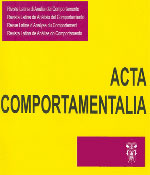Modeling the temporal control of Behavior under contingencies of reinforcement: A review
DOI:
https://doi.org/10.32870/ac.v9i2.14639Keywords:
temporal control, SET, BeT, LeT, dynamical systms, nonlinear dynamies, variability.Abstract
Timing behaviour is a major concern in behavioural analysis and many models have been developed. Two kinds of models can be distinguished. The first view is originally of models with a common characteristic, the determination of the time stimulus dimension with at least one internal clock. These first one postulates the existence of an internal clock and focuses on asymptotic properties of behaviour, like scalar timing property.These models differ from each other by the nature of the cognitive procesess they used to explain timing. One second view, by considering the dynamics of behaviour, is interested in the acquisition of the temporal control. These models do not requiere an internal clock to adjust to temporal regularities. Linear, and nonlinear models have been proposed. A few concepts of the nonlinear approach will be specified, specially about variability, and mothods will be clarified. Our purpose si to discuss the interest of this approach in the analysis and the modeling of behaviour in reinforcement schedules.
Downloads
Downloads
How to Cite
Issue
Section
License

<a rel="license" href="http://creativecommons.org/licenses/by-nc-sa/4.0/"><img alt="Licencia de Creative Commons" style="border-width:0" src="https://i.creativecommons.org/l/by-nc-sa/4.0/88x31.png" /></a><br />Este obra está bajo una <a rel="license" href="http://creativecommons.org/licenses/by-nc-sa/4.0/">licencia de Creative Commons Reconocimiento-NoComercial-CompartirIgual 4.0 Internacional</a>.






